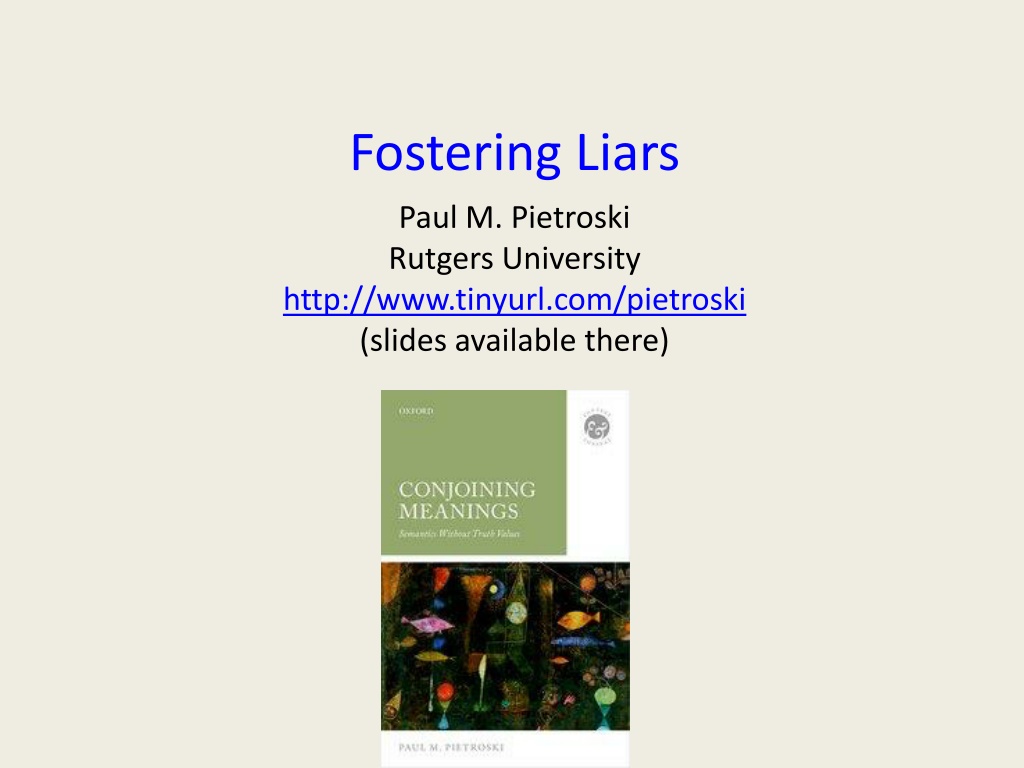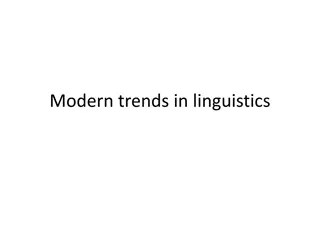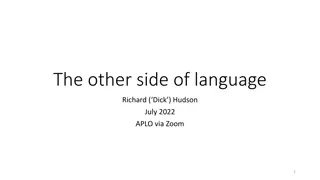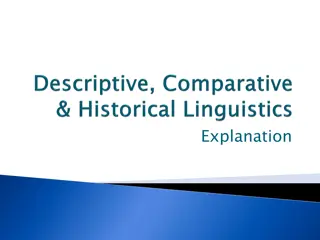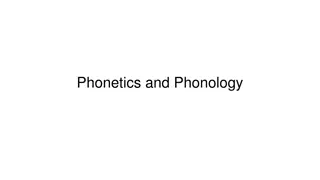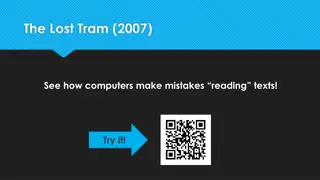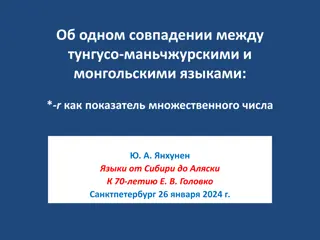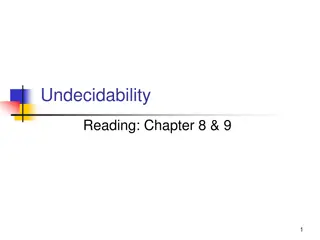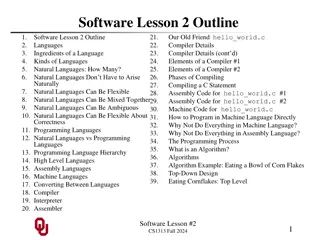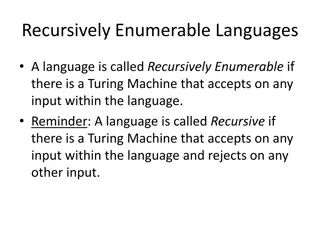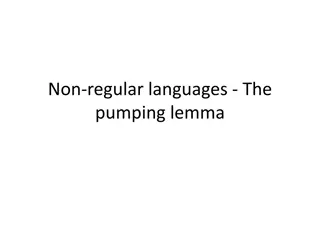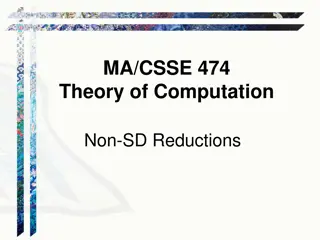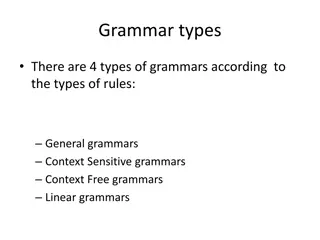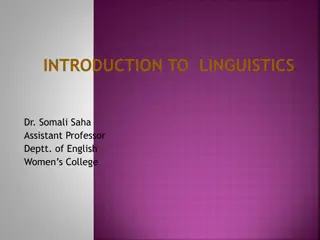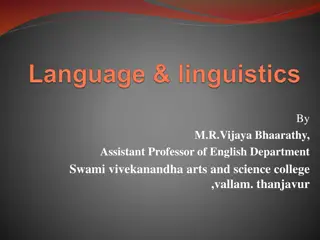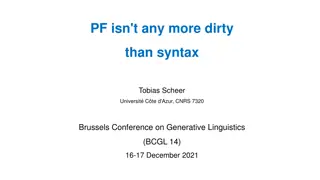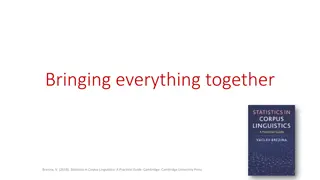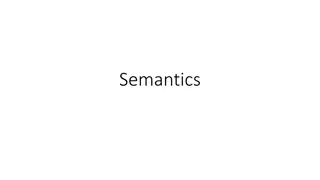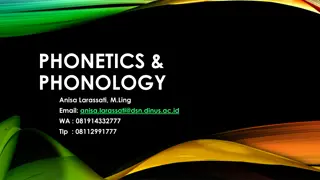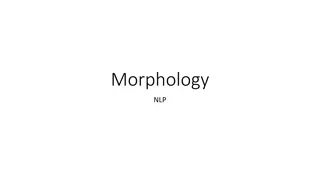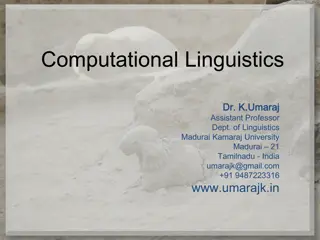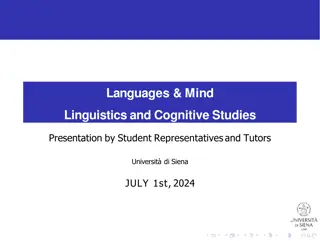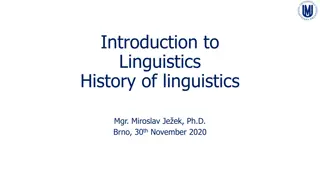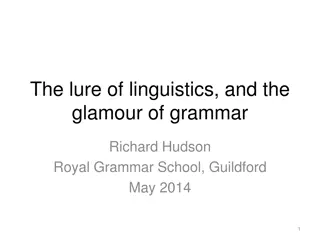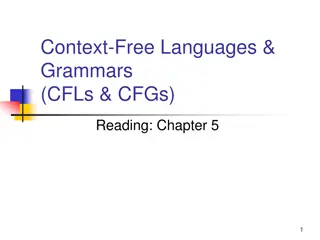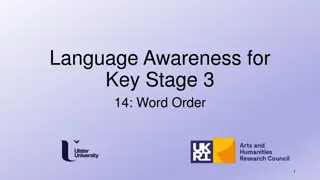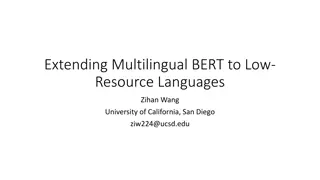Understanding Languages and Meaning in Linguistics
The content explores the connection between languages, slangs, meanings, and pronunciations in human communication. It delves into theories by scholars like Davidson, Dummett, and Chomsky regarding the understanding and truth theories associated with languages and slangs.
Download Presentation

Please find below an Image/Link to download the presentation.
The content on the website is provided AS IS for your information and personal use only. It may not be sold, licensed, or shared on other websites without obtaining consent from the author. Download presentation by click this link. If you encounter any issues during the download, it is possible that the publisher has removed the file from their server.
E N D
Presentation Transcript
Fostering Liars Paul M. Pietroski Rutgers University http://www.tinyurl.com/pietroski (slides available there)
Languages: connect interpretations of some kind with signals of some kind Slangs: spoken/signed languages that children can naturally acquire Languages Slangs connect meanings with pronunciations in ways that are unbounded but also interestingly constrained. Slangs the duck is ready to eat the duck is ready to dine the duck is pret-a-manger one pronunciation, two meanings # the duck is eager to be one who is eaten the duck is eager to eat the duck is eager to be one who eats one meaning, not two # It is easy for the duck to eat (some food) It is easy (for us) to eat the duck the duck is easy to eat one meaning, not two
Languages: connect interpretations of some kind with signals of some kind Slangs: spoken/signed languages that children can naturally acquire Languages Slangs connect meanings with pronunciations in ways that are unbounded but also interestingly constrained. Slangs the duck is ready to eat the duck is ready to dine the duck is pret-a-manger one pronunciation, two ways of understanding it # the duck is eager to be one who is eaten the duck is eager to eat the duck is eager to be one who eats one meaning, not two # It is easy for the duck to eat (some food) It is easy (for us) to eat the duck the duck is easy to eat one meaning, not two
Davidsons Conjecture: for each Slang, S, there is a truth theory that is also the core of an adequate theory of meaning for S Dummett s Questions: What is a theory of meaning? What is it a theory of? What are we trying describe/explain? Chomsky s Facts: There are interesting limits on how speakers of Slangs can connect meanings with pronunciations. We understand speech in human ways.
What is a Theory of Meaning for a Slang? Dummett sSuggestion (and Chomsky s, and , and mine) a theory of meaning is a theory of understanding a partial theory of the linguistic competence that certain human beings have acquired a theory ofunderstanding won t be a theory of truth (different topics, explananda, and governing laws ) one can hypothesize that a theory of understanding for a Slang will include a truth theory i.e., a theory whose theorems specify truth conditions for the declarative sentences of the Slang but it s bold to posit truth theories for Slangs it s very bold to posit them as core components of meaning theories
For today, lets bracket many concerns about the Very Bold Conjecture polysemy, requisite ontology, difficulty of evaluating proposals specific constructions, contextual dependence, vagueness paucity of parade cases evidence that meaning is compositional in ways that truth isn t and focus on a pair of old concerns Can there be true truth theories for languages that generate (1) and (2)? (1) The first numbered sentence in this talk is not true. (2) My favorite sentence is not true. How can analogs of (3) help if there are equally true analogs of (4)? (3) Snow is white is true if and only if snow is white. (4) Snow is white is true if and only if ei?+ 1 = 0. John Foster Truth is representation-neutral in ways that meaning isn t.
Two Sides of a Major Problem if a Slang sentence S has the truth-theoretic property ascribed by a Davidsonian T-sentence, then given some truths, S has the truth-theoretic properties ascribed by other T-sentences In some cases, it seems that if S has the Davidsonian property ascribed to it, then S has properties that are logically incompatible. (1) The first numbered sentence is not true. Prima facie, a Davidsonian truth/meaning theory for English will imply (1a). (1a) relative to any context C, True[(1)] ~True[the first numbered sentence in C] (1b) relative to the actual context C*, True[(1)] ~True[the first numbered sentence in C*] (1a) (1) = first numbered sentence in C* True[(1)] ~True[(1)] fact That s not a paradox. It s an argument that (1a) is false.
Two Sides of a Major Problem if a Slang sentence S has the truth-theoretic property ascribed by a Davidsonian T-sentence, then given some truths, S has the truth-theoretic properties ascribed by other T-sentences In some cases, it seems that if S has the Davidsonian property ascribed to it, then S has properties that are logically incompatible. (1) The first numbered sentence is not true. For any truth theory that initially looks plausible as a theory of meaning, many equally true truth theories are implausible as theories of meaning. (3) Snow is white is true if and only if snow is white. T-sentence (F) Snow is white if and only if ei?+ 1 = 0. (4) Snow is white is true if and only if ei?+ 1 = 0. T if snow is white as true as (3) Davidsonians need to say how a truth theory of the right sort could ever be the core of a good theory of meaningfor a Slang.
Rest of the Talk Foster s Problem Standard Replies: Spare Axioms and Canonical Derivations Retort: what s the role of truth in a theory of meaning? Liar Sentences Standard Replies: Sophisticated Axioms and Clever Rules Retorts: Spare and Sophisticated? Canonical and Clever? Also, what s the role of truth in a theory of meaning? It s hard to see how a plausible hypothesis about how expressions are truth-theoretically related to the world could do double-duty as a plausible hypothesis about how expressions are understood. Truth is representation-neutral in ways that meaning isn t.
Deriving T-sentences (A1) x[TrueOf(walksVerb, x) Walks(x)] (A2) x[TrueOf(talksVerb, x) Talks(x)] (A3) x[TrueOf(ErnieName, x) (x = Ernie)] (A4) x[TrueOf(BertName, x) (x = Bert)] (A5) True([ Name Verb]Sentence) x[TrueOf( Name, x) & TrueOf( Verb, x)] (T1) True([ErnieName walksVerb]Sentence) x[TrueOf(ErnieName , x) & TrueOf(walksVerb, x)] x[ x = Ernie & Walks(x)] Suppressing many complexities tense, event variables, polysemy, genericity,
Deriving T-sentences (A1) x[TrueOf(walksVerb, x) Walks(x)] (A2) x[TrueOf(talksVerb, x) Talks(x)] (A3) x[TrueOf(ErnieName, x) (x = Ernie)] (A4) x[TrueOf(BertName, x) (x = Bert)] (A5) True([ Name Verb]Sentence) x[TrueOf( Name, x) & TrueOf( Verb, x)] (T2) True([BertName talksVerb]Sentence) x[TrueOf(BertName , x) & TrueOf(talksVerb, x)] x[ x = Bert & Talks(x)] Parallel theorems for [BertName walksVerb]Sentence and [ErnieName talksVerb]Sentence
Deriving Unwanted T-sentences Let T be any true sentence e.g., Bert talks or ei?+ 1 = 0 or x[x = Bert & Talks(x)] or True([BertName talksVerb]Sentence) x[x = Bert & Talks(x)] (A1*) x[TrueOf(walksVerb, x) T &Walks(x)] (A3) x[TrueOf(ErnieName, x) (x = Ernie)] (A5) True([ Name Verb]Sentence) x[TrueOf( Name, x) & TrueOf( Verb, x)] (T1*) True([ErnieName walksVerb]Sentence) x[TrueOf(ErnieName , x) & T & TrueOf(walksVerb, x)] x[ x = Ernie & T & Walks(x)]
Deriving Unwanted T-sentences Let T be any true sentence e.g., Bert talks or ei?+ 1 = 0 or x[x = Bert & Talks(x)] or True([BertName talksVerb]Sentence) x[x = Bert & Talks(x)] (A1) x[TrueOf(walksVerb, x) Walks(x)] (A3*) x[TrueOf(ErnieName, x) T & (x = Ernie)] (A5) True([ Name Verb]Sentence) x[TrueOf( Name, x) & TrueOf( Verb, x)] (T1*) True([ErnieName walksVerb]Sentence) x[TrueOf(ErnieName , x) & T & TrueOf(walksVerb, x)] x[ x = Ernie & T & Walks(x)]
Deriving Unwanted T-sentences Let T be any true sentence e.g., Bert talks or ei?+ 1 = 0 or x[x = Bert & Talks(x)] or True([BertName talksVerb]Sentence) x[x = Bert & Talks(x)] (A1) x[TrueOf(walksVerb, x) Walks(x)] (A3) x[TrueOf(ErnieName, x) (x = Ernie)] (A5*) True([ Name Verb]Sentence) x[TrueOf( Name, x) & T & TrueOf( Verb, x)] (T1*) True([ErnieName walksVerb]Sentence) x[TrueOf(ErnieName , x) & T & TrueOf(walksVerb, x)] x[ x = Ernie & T & Walks(x)]
Deriving Unwanted T-sentences (A1) x[TrueOf(walksVerb, x) Walks(x)] (A3) x[TrueOf(ErnieName, x) (x = Ernie)] (A5) True([ Name Verb]Sentence) x[TrueOf( Name, x) & TrueOf( Verb, x)] Let T be a theorem of some true theory (T1) True([ErnieName walksVerb]Sentence) x[TrueOf(ErnieName , x) & TrueOf(walksVerb, x)] x[ x = Ernie * x[ x = Ernie & Walks(x)] &T & Walks(x)] What makes the special axioms and derivations special?
Spare Axioms, Canonical Derivations Even if T is a theoremof some true theory (A1) x[TrueOf(walksVerb, x) T & Walks(x)] (A3) x[TrueOf(ErnieName, x) T & (x = Ernie)] (A5) True([ Name Verb]Sentence) x[TrueOf( Name, x) T & TrueOf( Verb, x)] (T1) True([ErnieName walksVerb]Sentence) x[TrueOf(ErnieName , x) & TrueOf(walksVerb, x)] x[x = Ernie & Walks(x)] * x[x = Ernie & Walks(x)] & T True(S) p S means that p Erniewalks means that x[x = Ernie & Walks(x)] * Walks(Ernie)
Spare Axioms? x[TrueOf(VenusName, x) (x = Venus)] * x[TrueOf(HesperusName, x) (x = Phosphorus)] * x[TrueOf(HesperusName, x) (x = Hesperus) & (Hesperus = Phosphorus)] x[TrueOf(groundhogNoun, x) x is a groundhog] * x[TrueOf(groundhogNoun, x) x is a woodchuck] * x[TrueOf(groundhogNoun, x) x is a whistlepig] * x[TrueOf(woodchuckNoun, x) x is a whistlepig]
Spare Axioms? True( ? and ? ) True( ? ) & True( ? ) True(S) p S means that p Ernie walks and Bert talks means that x[x = Ernie & Walks(x)] & x[x = Ernie & Walks(x)] P Q P&Q ~P ~Q P Q P P Q Q (P P) (Q Q) 1 1 1 0 0 0 0 0 1 1 0 0 0 1 0 0 1 0 0 1 0 1 0 0 1 0 0 0 0 0 1 1 1 1 1 0 True( ? and ? ) [True( ? ) True( ? )] [True( ? ) True( ? )] Ernie walks and Bert talks means that { x[x = Ernie & Walks(x)] x[x = Ernie & Walks(x)]} { x[x = Bert & Talks(x)] x[x = Bert & Talks(x)]}
Sensy Axioms, Canonical Derivations True( ? and ? ) True( ? ) & True( ? ) * True( ? and ? ) [True( ? ) True( ? )] [True( ? ) True( ? )] x[TrueOf(VenusName, x) (x = Venus)] * x[TrueOf(HesperusName, x) (x = Phosphorus)] True([VenusName shinesVerb]Sentence) x[TrueOf(VenusName , x) & TrueOf(shinesVerb, x)] x[x = Venus & Shines(x)] * x[x = Venus & Shines(x)] & T * Shines(Venus) Larson & Segal: heavily blinkered (anti-omniscient) rules R1. Axiom Instantiation R2. if ?(x) and ?(x) ?(x), then ?(x) a few other rules
Sensy Axioms, Sensy Derivations TrueOf([what1 [Bert saw ti]Sentence]RelClause, x) Bert saw x Relative to any assignment A of values to variables TrueOf([what1 [Bert saw t1]Sentence]RelClause, x) (a) for some assignment A* such that A* 1A & A*(1) = x, [Bert saw t1]Sentence is true relative to A* (b) for some assignment A* such that A* 1A & A*(1) = x, some event prior to A*(time) is an event of Bert seeing A*(1) (c) for some assignment A* such that A* 1A & A*(1) = x, some event prior to A(time) is an event of Bert seeing x (d) some event prior to A(time) is an event of Bert seeing x Is this derivation canonical? How does this differ from an untruthy mentalistic proposal?
Meanings as Instructions for How to Build Concepts * HesperusName HESPERUS & =(HESPERUS, PHOSPHORUS) * HesperusName PHOSPHORUS HesperusName HESPERUS FranceName FRANCEPLACE, , FRANCEPOLIS London/Londres Jerusalem/al-Quds [FranceName [is hexagonal]VerbPhrase]Sentence X[=(X, {FranceName}) & [is hexagonal]VerbPhrase(X)] X[=(X, FRANCEPLACE) & HEXAGONAL(X)] X[=(X, FRANCEPOLIS) & HEXAGONAL(X)] [FranceName [is a republic]VerbPhrase]Sentence X[=(X, {FranceName}) & [is hexagonal]VerbPhrase(X)] X[=(X, FRANCEPLACE) & REPUBLIC(X)] X[=(X, FRANCEPOLIS) & REPUBLIC(X)]
Meanings as Instructions for How to Build Concepts * HesperusName HESPERUS & =(HESPERUS, PHOSPHORUS) * HesperusName PHOSPHORUS HesperusName HESPERUS FranceName FRANCEPLACE, , FRANCEPOLIS You can stipulate that this isn t a real semantics But then maybe a theory of meaning (for a Slang) isn t a real semantics [what1 [Bert saw t1]Sentence]RelClause E[BEFORE(E, A(TIME)) & SEEINGBYOF(E, BERT, X)] if Davidsonians reject this mentalistic conception of meaning as inadequate, they need to say how insisting on one word, one extension with sensy axioms and canonical derivations is better.
Recall: Two Sides of a Major Problem if a Slang sentence S has the truth-theoretic property ascribed by a Davidsonian T-sentence, then given some truths, S has the truth-theoretic properties ascribed by other T-sentences In some cases, it seems clear that if S has a Davidsonian property, then S has properties that are logically incompatible. For any truth theory that initially looks plausible as a theory of meaning, endlessly many equally true theories are implausible as theories of meaning. In short, Davidsonians need a logic for deriving theorems that is Clever Enough to not yield contradictions given Liar Sentences, and yet Dumb Enough to not generate theorems that trigger Foster s Problem
Back to the First Side of a Major Problem if a Slang sentence S has the truth-theoretic property ascribed by a Davidsonian T-sentence, then given some truths, S has the truth-theoretic properties ascribed by other T-sentences In some cases, it seems clear that if S has a Davidsonian property, then S has properties that are logically incompatible. (1) The first numbered sentence is not true. (1a) relative to any context C, True[(1)] ~True[the first numbered sentence in C] (1b) relative to the actual context C*, True[(1)] ~True[the first numbered sentence in C*] the first numbered sentence in C* = (1) True[(1)] ~True[(1)] That s not a paradox. It s an argument that (1a) is false. And if (1) is not true, then my/your/our thought that (1) is not true is true.
Back to the First Side of a Major Problem if a Slang sentence S has the truth-theoretic property ascribed by a Davidsonian T-sentence, then given some truths, S has the truth-theoretic properties ascribed by other T-sentences In some cases, it seems clear that if S has a Davidsonian property, then S has properties that are logically incompatible. (2) My favorite sentence is not true. (2a) relative to any context C, True[(2)] ~True[the favorite sentence of C(speaker)] conjecture (2b) relative to the actual context C*, True[(2)] ~True[the favorite sentence of C*(speaker)] (2) = the favorite sentence of C*(speaker) True[(2)] ~True[(2)] truthy (2a) (fact) That s not a paradox. It s an argument that (2a) is false.
Pervasive Liars (6) Most of the sentences in there1 are not true. (7) Most of the sentences in Boxy are not true. (D) relative to any context C, True[(6)] Most of the sentences in C(1) are not true True[(7)] Most of the sentences in Boxy are not true (K) relative to the actual context C*, --C*(1) is a box that contains nine sentences: four true ones (e.g., 1 =1 ) four false ones (e.g., 1 =2 ) Most of the sentences in Boxy are not true --so given (D), True[(6)] ~True[(7)] --C*(1) = Boxy --so given (D), True[(6)] True[(7)] That s not a paradox. It s an argument that hypothesis (D) is false.
Sophisticated Axioms and Clever Rules? You can hypothesize that trueisn t like blue x[TrueOf(blueAdjective, x) Blue(x)] ~ x[TrueOf(trueAdjective, x) True(x)] --Kripke-style Hierarchies with Fixed Points --Gupta-Belnap Revisions --Your Favorite Proposal here: for any sentence S, True(S) But why think the axioms and rules for deriving theorems will be suitably sensy and yield canonical (meaning specifying) theorems? Moreover, the Slang adjective true is not a sentential operator like P P ~P 1 1 0 0 0 1 Not even not is a sentential operator (8) It is true that snow is not green. (9) It isn t truethat snow is green.
Sophisticated Axioms and Clever Rules? There are endlessly many sentences like (2) and (10). (10) That sentence is true. (11) No true sentence in that box contains nine words. So we still need Foster-appropriate axioms of some kind. x[TrueOf(blueAdjective , x) Blue(x)] x[TrueOf([is Adjective]VerbPhrase , x) TrueOf( Adjective , x)] x[TrueOf([is true???]VerbPhrase , x) ???] x[TrueOf([ Adj Noun]NounPhrase), x) TrueOf( Noun, x)] & TrueOf( Adj , x) x[TrueOf([true??? Noun]NounPhrase, x) TrueOf( Noun, x) & ??? ]
Radical Reply 1 (time permitting): Dont Worry about Liars a Truth Theory for a Fragment of a Slang can be good enough A full response would require a discussion of what Slangs are. But in any case, why think the ordinary words blue and true differ in kind? we can use true to vividly illustrate a certain objection to the VBC examples with bluedon t illustrate the objection in the same way but don t confuse epistemology with conclusions an impoverished lexicon will fail to illustrate many problems for the VBC but why think that with regard to meaning/understanding, is true and true sentence are special, compared with is blue and blue string? if we bracket fake diamond and thinks that Venus is Phosphorus, we owe reasons for treating these constructions as special ignoring words that illustrate objections is no defense of the VBC to evaluate combinatorial axioms, we need to see what they imply
Radical Reply 2 (time permitting): Dont Worry about Liars a false Truth Theory for a Slang can be good enough A full discussion would require a longer talk. But for 50+ years, the line has been that endlessly many biconditionals like (12) are true, and that these truths are explananda for theories of meaning. (12) True([ErnieName walksVerb]Sentence) x[x = Ernie & Walks(x)] But if we don t have to explain why biconditionals like (12) are true, why think truth plays a special role in theories of meaning? And in what ways is it OK for a proposed truth theory to be false? What counts as getting it wrong in semantics? If theorems like (12) are merely interpretive in that their right sides provide decent regimentations of the Slang sentences why not omit talk of truth, and view the right sides as proposed mental translations ?
Once upon a time, the Very Bold Conjecture was a very bold conjecture, as opposed to a dogmatic ground rule. Advocates worried about extensionally equivalent theories; and at least some of them worried about Liar Sentences.
Once upon a time, the Very Bold Conjecture was a very bold conjecture, as opposed to a dogmatic ground rule. Advocates worried about extensionally equivalent theories; and at least some of them worried about Liar Sentences. It has become standard to ignore these issues. But thinking about Foster s Problem and Liar Sentences together highlights an old (and perhaps fatal) objection to the VBC: It s hard to see how any plausible hypothesis about how expressions are truth-theoretically related to the world can do double-duty as a plausible hypothesis about how expressions are understood. for each Slang, S, there is a truth theory that is also the core of an adequate theory of meaning for S a theory of meaning/understanding is a partial theory of a competence acquired by certain humans; and the competence is not truth-theoretic
Once upon a time, the Very Bold Conjecture was a very bold conjecture, as opposed to a dogmatic ground rule. Advocates worried about extensionally equivalent theories; and at least some of them worried about Liar Sentences. It has become standard to ignore these issues. But thinking about Foster s Problem and Liar Sentences together highlights an old (and perhaps fatal) objection to the VBC: it s hard to see how any plausible hypothesis about how expressions are truth-theoretically related to the world can do double-duty as a plausible hypothesis about how expressions are understood. So let s not confuse theories of how expressions are understood with theories of what it is for uses of sentences (Slang or Mental) to be true. And let s admit that externalist constraints on truth/reference need not be constraints on meaning/understanding.
For Specialists: Bracketing a Distraction (to Save Time) if a Slang sentence S has the truth-theoretic property ascribed by a Davidsonian T-sentence, then given some truths, S has the truth-theoretic properties ascribed by other T-sentences Don t confuse Onto-Logically Fancy theories of truth/meaning for Slangs TRUE-IFF( Snow is white , ?????) ????? ei?+ 1 = 0 ~TRUE-IFF( Snow is white , ei?+ 1 = 0) with truth-maker proposals regarding invented (or mental) languages. If neo-Davidsonians also posit a logic for fine-grained contents, they need to say why the net result is a plausible truth theory for a Slang as opposed to an algorithm that pairs Slang expressions with mental representations. And in my view, positing representation-neutral contents doesn t help.
(13) No true sentence in Ziggy has eight words. Ziggy contains nine sentences, one of which is (13) four true ones, none of which has eight words (e.g., 1 = 1 ) four false ones, none of which has eight words (e.g., 1 = 2 ) No true sentence in Ziggy has eight words If (13) is true, then one true sentence in Ziggy has eight words. But if (13) is true, then no true sentence in Ziggy has eight words. So (13) isn t true, and no true sentence in Ziggy has eight words; So if (13) is true iff no true sentence in Ziggy has eight words, then (13) is true--and hence, (13) is both true and not true; So it s not true that (13) is true iff no true sentence in Ziggy has eight words. ----------------------------------------------------------------------------------------------- (14) Most of the sentences in Ziggy are not true. (6) Most of the sentences in there1 are not true. (7) Most of the sentences in Lari are not true. It s true that most of sentences in Ziggy are not true. But it doesn t follow that (14) has a truth condition; recall (6), (7), and (13).
(1) This sentence is not true if in the actual context C*, THISSENTENCE is used to think about (1), then in C*, an affirmative use of ~[TRUE(THISSENTENCE)] is true. (2) My favorite sentence is not true if in the actual context C*, MYFAVORITESENTENCE is used to think about (2), then in C*, an affirmative use of ~[TRUE(MYFAVORITESENTENCE)] is true. (3) This utterance is not true if in C*, THISUTTERANCE is used to think about the utterance of (3) in C*, then in C*, an affirmative use of ~[TRUE(THISUTTERANCE)] is true. (4) This use of this mental sentence is not true. if in C*, THISUSEOFTHISMENTALSENTENCE is used to think about the episode e of my affirmatively using the corresponding mental sentence, then in C*, my affirmative use u of ~[TRUE(THISUSEOFTHISMENTALSENTENCE)] is not true. For u is e, and e is not true. (If e is true, it is both true and not true.) So there is no sound route to the conclusion that uis true. And it s false that ~[TRUE(THISUSEOFTHISMENTALSENTENCE)] is true relative to C* iff u is not true. For a use of a mental sentence to be truth-evaluable or if you prefer, for a context to be legitimate (non-defective) the world has to cooperate. The mental sentence THISUSEOFTHISMENTALSENTENCEISNOTTRUE has a character that does not map each situation to truth or falsity.
Between Meaning and Truth Slang expressions are not themselves truth-evaluable. But a Slang sentence connects a pronunciation p with meaning m that can be used to build a Mental Sentence (thought). Affirmative uses of Mental Sentences can be true or false. But the details are complicated. Utterances of Slang sentences can be true or false. But the details are more complicated. Don t race in with forensic questions about what speakers are committed to.
then ||pigs talk nad quails fly||= T iff (pigs talk pigs talk) (quails fly quails fly) = Tiff (pigs talk | quails fly) | (pigs talk | quails fly) if ||pigs talk nad quails fly||= T iff pigs talk & quails fly, then ||ont pigs talk||= T iff (pigs talk pigs talk) = Tiff (pigs talk | pigs talk) if ||ont pigs talk||= T iff ~(pigs talk), then ||pigs talk orn quails fly||= T iff (pigs talk quails fly) if ||pigs talk orn quails fly||= T iff ~(pigs talk) & ~(quails fly), and A(s) = Pietroski, and FAVE[Pietroski] = my favorite sentence is not true, then FAVE[A(s)] = my favorite sentence is not true, and hence, True{FAVE[A(s)]} & ~True{FAVE[A(s)] if ||my favorite sentence is not true||A= T iff ~True{FAVE[A(s)]},
Actually, Three Sides of an Overgeneration Problem It s not enough to provide a theory pairs each declarative sentence S with a true theorem of the form True(S) p or TrueRelativeTo(S, c) F(c) . The truth theory has to reflect how the sentences are understood. But if the theory yields falsetheorems, that s also a problem. And theorists can misdescribe a language in many ways. (2) My favorite sentence is not true. True(2) ~True(2) (15) the duck is eager to eat (15a)the duck is eager to be one who eats (15b) the duck is eager to be one who is eaten In virtue of what is it false that (15) has both meanings?
Languages: connect interpretations of some kind with signals of some kind. Slangs: spoken or signed languages that children can naturally acquire Slangs connect meanings with pronunciations in ways that are unbounded but also interestingly constrained. a magician saw an astronomer with binoculars a magician saw an astronomer who had binoculars a magician saw an astronomer by using binoculars a magician saw an astronomer and had binoculars two meanings, not three Acquiring a Slang is a matter of acquiring a procedure that generates certain meaning-pronunciation pairs, but not others.
Object Language: P Q P nad Q ont P P orn Q 1 1 1 0 0 1 0 0 0 0 0 1 0 1 0 0 0 0 1 1 P.~P = P. P P = P. P|P P. Q.P&Q = P. Q. (P P) (Q Q) = P. Q.((P|Q)|(P|Q)) Metalanguage: P Q P&Q ~P ~Q P Q P P Q Q (P P) (Q Q) PvQ (P Q) (P Q) 1 1 1 0 0 0 0 0 1 1 1 0 0 0 1 0 0 1 0 1 1 0 1 0 1 0 0 1 0 0 1 1 0 0 0 1 1 1 1 1 0 0 0 1 P Q P&Q ~P ~Q P|Q P|P Q|Q ((P|Q)|(P|Q)) PvQ ((P|P)|(Q|Q)) 1 1 1 0 0 0 0 0 1 0 0 0 1 1 0 1 0 1 0 1 0 1 1 0 0 0 0 1 1 1 1 1 1 0 0 0 1 1 1 1 1 1 0 0
if ||nad|| = P.Q.P&Q, then ||nad|| = P. Q.(P P) (Q Q) = P. Q.((P|Q)|(P|Q)) Object Language: P Q P nad Q ont P P orn Q 1 1 1 0 0 1 0 0 0 0 0 1 0 1 0 0 0 0 1 1 if ||ont|| = P.~P, then ||ont|| = P. P P = P. P|P if ||orn|| = P. Q.~P&~Q, then ||orn||= P. Q.(P Q) Metalanguage: P Q P&Q ~P ~Q P Q P P Q Q (P P) (Q Q) PvQ (P Q) (P Q) 1 1 1 0 0 0 0 0 1 1 1 0 0 0 1 0 0 1 0 1 1 0 1 0 1 0 0 1 0 0 1 1 0 0 0 1 1 1 1 1 0 0 0 1 P Q P&Q ~P ~Q P|Q P|P Q|Q ((P|Q)|(P|Q)) PvQ ((P|P)|(Q|Q)) 1 1 1 0 0 0 0 0 1 0 0 0 1 1 0 1 0 1 0 1 0 1 1 0 0 0 0 1 1 1 1 1 1 1 1 0 1 1 0 1 1 0 0 0
eix = cosine(x) + i[sine(x)] where the argument to the trigonometric functions is given in radians so ei?= cosine(?) + i[sine(?)] = 1 + i[0] = 1 so ei?+ 1 = 0
